|
|
Volume 9, Issue 11, June 2023
Incorporating Agricultural Activities into Your Summer Learning Programs
|
|

In many regions across the United States, summer aligns with peak growing season, but also flourishes just as the school year ends. However, Schenectady City School District decided to take advantage of New York’s prime growing season and applied for and received a Fiscal Year (FY) 2019 Patrick Leahy Farm to School Program Planning Grant to install school gardens and further develop farm to school curriculum for the District’s Summer Enrichment Program (SEP), which serves over 1,500 students each summer.
Rebekka Henriksen, Schenectady City School District’s Farm to School Projects Manager, designed and developed an interactive four-week program for the SEP. This garden-based curriculum includes daily lessons and accompanying activities, on food systems, soil health and plant cultivation, composting efforts, and the science of food growth and production. One of students’ favorite lessons focused on vermicomposting (worm composting) and taking an up-close look at red wriggler worms with hand lenses while using Q-tips for probes.
|

The SEP curriculum was initially piloted with second graders. The program has since expanded to grades K-8 in summer 2022, and this summer the goal is to further expand the program to include high school students. Rebekka designed the curriculum to be flexible according to grade level, with different reading assignments, deeper reflection and discussion questions, and modifications to activities.
When the students are not busy engaging in lessons, taking fieldtrips to local urban farms, or constructing a beehive, they can be found in one the 15 gardens that are located throughout the school district. During SEP, the students plant lettuce, kale, broccoli, basil, tomatoes, peppers, okra, eggplant, carrots, and radishes. “I love that students can help plant crops during the SEP, that they will then harvest in the fall. Students who participate over the summer usually return to school looking for what they planted and telling their friends about everything from seed anatomy to photosynthesis!” said Rebekka when asked about the District’s Farm to Summer program.
|
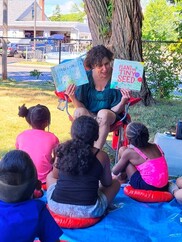
Additionally, this summer, Farm to Summer is expanding beyond the SEP. The Schenectady City School District is joining forces with a community partner that participates in USDA’s Summer Food Service program, to offer farm to school garden activities, nutrition education, and reach more students with healthy, local lunches.
While the Schenectady City School District continues to do great work with their farm to summer activities, they stay busy with farm to school activities year-round! In addition to all the summer programming, the school also partakes in school yard sugaring. This is done on five school campuses, reaching almost 600 students who help tap trees on the campus, collect the sap, and get to taste the syrup! Another exciting project, done with the help of local agencies and community partners is a school-wide composting program at one of the elementary schools, where all edible waste is diverted to a solar-powered, aerated composting system at a nearby urban farm. The compost created will be used in all of the school gardens.
|
|
|
 |
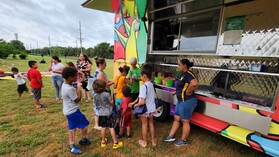
Welcome Changes Coming to USDA Summer Meal Programs
Starting this summer, USDA summer meal programs can serve meals to more children, especially in rural communities, where meals can be provided through pickup or delivery, rather than being served and consumed at group sites. Beginning in 2024 – and continuing every summer going forward – States can provide households with summer food benefits if they have school children eligible for free or reduced-price school meals. These benefits help families buy groceries for their children, while still having the support of other summer meal programs to help get kids the nourishment they need.
The Consolidated Appropriations Act, 2023, authorized a permanent option of non-congregate meal service through the Summer Food Service Program (SFSP) for rural areas with no congregate meal service. It also made permanent the Summer Electronic Benefits Transfer for Children program. The non-congregate model for rural areas is available in summer 2023 and Summer EBT will be available in summer 2024. These changes could potentially benefit 8 million children in rural areas this year, and an additional 29 million children nationwide starting next year. Families can look for information on the SFSP from their local schools or find a nearby meal service site by texting “Summer Meals” to 914-342-7744, calling 1-866-348-6479, or clicking here.
|

Connecting Local Producers to Montana Schools
In 2019, the USDA, the National Center for Appropriate Technology, and the National Farm to School Network established a cooperative agreement to develop “Bringing the Farm to School,” a farm to school curriculum and training program to help agricultural producers increase efforts to market to schools. Recently in Montana, partners from the USDA Mountain Plains Regional Office, Montana Team Nutrition, Mission Mountain Food Enterprise Center, and Abundant Montana implemented the training program by bringing together local producers and schools within the State. This event covered many topic areas, such as how to approach schools and procurement considerations, with the overall goal to build relationships between schools and producers to increase the availability of local foods served to children. Read the full USDA blog post about this exciting and innovative event.
|

Advancing Food and Nutrition Security
USDA is excited to introduce our new Director of Nutrition Security and Health Equity, Dr. Caree Cotwright! No stranger to the farm to school community, Dr. Cotwright was a former member of the National Farm to School Network Advisory Board and has extensive experience and passion for farm to early childcare and education initiatives. Dr. Cotwright will be leading Agency efforts to support USDA Secretary Vilsack’s core priority to tackle food and nutrition insecurity. She will also serve on the White House Domestic Policy Council Nutrition Interagency Policy Committee, as part of the Biden-Harris Administration National Strategy on Hunger, Nutrition, and Health. All this work aims to accelerate progress on the White House goals to end hunger, improve nutrition and physical activity, and reduce diet-related diseases and disparities. USDA knows we can’t achieve these goals without the help of our various partners – including all of you who work tirelessly in community food systems. In the months ahead, Dr. Cotwright will provide updates on her work and highlight opportunities for engagement! Please reach out to her if you have questions or food for thought for ways the food systems community can help accelerate progress on the White House goals at caree.cotwright@usda.gov.
|

Join USDA's Healthy Kids Campaign to Build Brighter, Healthier Future for America’s Children
USDA's Healthy Kids campaign supports the premise that a healthier future for our country starts with our children. Nutrition assistance programs do more than give kids food to eat, they teach children about the importance of nutrition, help them develop healthy habits, and connect them and their families with other important resources. Supporting healthy kids with good nutrition early in life sets kids up to thrive. That’s why USDA’s Food and Nutrition Service is coordinating across all our programs to strengthen child nutrition and break down barriers to good health. Share what you’re doing to support healthy kids by using the hashtag #HealthyKids and tag @USDANutrition and @MyPlate on Twitter.
|
|
|


New USDA Webpage on Serving Traditional Indigenous Foods in Child Nutrition Programs
USDA has created a new webpage to serve as an organized hub of technical assistance resources and policy guidance focused on serving traditional Indigenous Foods in the Child Nutrition Programs. The webpage houses resources such as the Crediting in Child Nutrition Programs Tip Sheet series, Crediting Handbook for the Child and Adult Care Food Program, Food Buying Guide for Child Nutrition Programs, Gardens in Tribal Communities fact sheet, and USDA standardized recipes.
USDA’s Food and Nutrition Service also released an update to the Food Buying Guide for the Child Nutrition Programs that allows users to search for traditional Indigenous foods such as tepary beans, dandelion greens, and pheasant that are similar to foods currently included in the Food Buying Guide.
|
Webinar Recording: Navigating the USDA Foods Database
USDA recently hosted a webinar that provided State agencies and school districts with instructions on how to navigate the USDA Foods Database to access vendor-specific product information, including nutrients, allergens, ingredients, and certifications. The webinar included a live Q&A for attendees to get their most pressing USDA Foods Database questions answered.

NFSN Racial Equity Learning Lab Interest Form
In partnership with the USDA, the National Farm to School Network is implementing the Racial Equity Learning Lab (the “Lab”) to advance racial equity within the farm to school movement. The Lab will be a collaborative space, designed for small groups to foster an intensive learning experience and engage around the challenges and opportunities for working with diverse, multi-racial audiences in their farm to school organizations, networks, and communities. Access a recording of a recent webinar about the Lab here.
If you are interested in applying to be part of the Lab’s first cohort, complete the interest form here by June 30th.
|
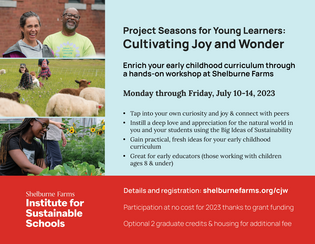
Farm to Early Childhood Professional Learning Program at Shelburne Farms
Early educators, you’re invited to deepen your farm to early childhood programming during a weeklong professional learning program at Shelburne Farms, Project Seasons for Young Learners: Cultivating Joy & Wonder. With support from USDA, this program is offered at no cost to participants excluding travel expenses. From July 10th to July 14th, tap into your curiosity and joy by connecting with peers; engaging with Shelburne Farm’s working farm campus (including gardens, farmyard, and forest); and learning practical, hands-on food and farm activities you can easily implement.
|
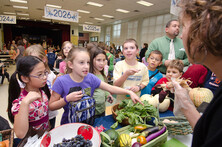
How To Plan a Student-Centered Farm Visit The Center for Ecoliteracy created a guide and planning template for schools to plan and host student-centered visits from local farmers. In 2022, the Center for Ecoliteracy facilitated 11 farmer visits to public schools in California. After the visits, insights and best practices from schools and farmers were collected and developed into a guide to help schools plan and host successful visits from local farmers. This guide is designed for all school personnel to use, including administrators, educators, and school nutrition professionals.
|
|
|

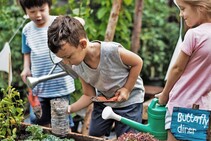
USDA National Agriculture in the Classroom Grant Program
The USDA National Institute of Food and Agriculture’s Agriculture in the Classroom Program will support projects that increase agricultural literacy through K-12 education. USDA will award approximately $960,000 in fiscal year 2023 to eligible applicants that will: ensure that future generations are agriculturally literate; encourage K-12 educators to integrate information about the food and agricultural system across curricula; and support a network of partners to carry out the program at the State and local levels.
Applications are due July 6, 2023.
|
USDA Funding Opportunity to Expand Meat and Poultry Processing for Underserved Producers and Tribal Communities
USDA’s new Indigenous Animals Harvesting and Meat Processing Grant Program will provide up to $50 million to expand value-added infrastructure related to harvesting and processing meat from indigenous animals like bison, reindeer, or salmon. An additional new program to support local meat processing capacity – the Local Meat Capacity Grant Program will provide up to $75 million in grant funds for innovative projects that expand meat and poultry producer’s local processing options and strengthen their market potential.
Applications for both programs are due July 19, 2023.
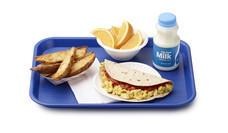
USDA School Breakfast Expansion Grant Program
Through the School Breakfast Expansion Grant Program USDA will award States, the District of Columbia, and U.S. Territories approximately $9 million in competitive funding to begin operation of or expand the School Breakfast Program. The program will provide sub-grants (not to exceed $10,000 per qualifying school or group of qualifying schools) to local education agencies to improve the nutritional quality of breakfast food, establish, maintain or expand a school breakfast program, and increase breakfast participation in qualifying schools. Applications are due by July 24, 2023.
Applications are due July 24, 2023.
|
USDA Outreach and Assistance for Socially Disadvantaged Farmers and Ranchers and Veteran Farmers and Ranchers Program
USDA’s Outreach and Assistance for Socially Disadvantaged Farmers and Ranchers and Veteran Farmers and Ranchers Program, also known as the 2501 Program will provide $45 million in grant funding for organizations that help underserved and veteran farmers, ranchers, and foresters to own and operate successful farm businesses. This program is administered by the USDA Office of Partnerships and Public Engagement. An informational webinar for grant applicants will be held on July 10, 2023.
Applications are due July 25, 2023.
|
|
|
USDA is an equal opportunity provider and employer. To file a complaint of discrimination, write: USDA, Office of the Assistant Secretary for Civil Rights, Office of Adjudication, 1400 Independence Ave., SW, Washington, DC 20250-9410 or call (866) 632-9992 (Toll-free Customer Service), (800) 877-8339 (Local or Federal relay), (866) 377-8642 (Relay voice users).
|
|
|
|
|